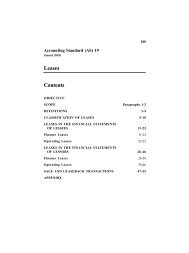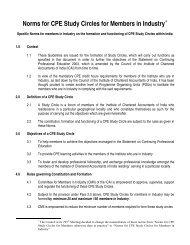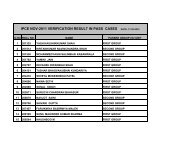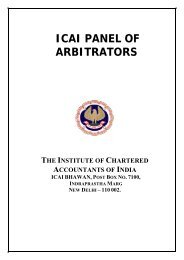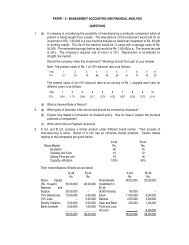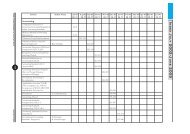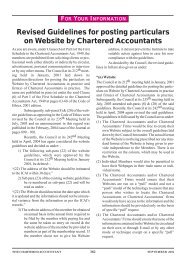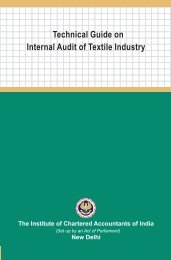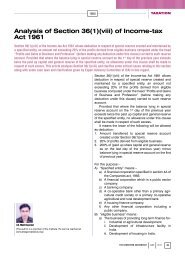Permutations and Combinations
Permutations and Combinations
Permutations and Combinations
Create successful ePaper yourself
Turn your PDF publications into a flip-book with our unique Google optimized e-Paper software.
<strong>Permutations</strong> <strong>and</strong><br />
<strong>Combinations</strong><br />
Quantitative Aptitude & Business Statistics
The Fundamental Principle of<br />
• If there are<br />
Multiplication<br />
• n 1 ways of doing one operation,<br />
• n 2 ways of doing a second<br />
operation, n 3 ways of doing a<br />
third operation , <strong>and</strong> so forth,<br />
Quantitative Aptitude & Business<br />
Statistics:<strong>Permutations</strong> <strong>and</strong> <strong>Combinations</strong><br />
2
• then the sequence of k<br />
operations can be performed in<br />
n 1 n 2 n 3 ….. n k ways.<br />
• N= n 1 n 2 n 3 … . n k<br />
Quantitative Aptitude & Business<br />
Statistics:<strong>Permutations</strong> <strong>and</strong> <strong>Combinations</strong><br />
3
Example 1<br />
• A used car wholesaler has agents<br />
who classify cars by size (full,<br />
medium, <strong>and</strong> compact) <strong>and</strong> age (0<br />
- 2 years, 2- 4 years, 4 - 6 years,<br />
<strong>and</strong> over 6 years).<br />
• Determine the number of possible<br />
automobile classifications.<br />
Quantitative Aptitude & Business<br />
Statistics:<strong>Permutations</strong> <strong>and</strong> <strong>Combinations</strong><br />
4
Full(F)<br />
Medium<br />
(M)<br />
Compact<br />
(C)<br />
Solution<br />
Quantitative Aptitude & Business<br />
Statistics:<strong>Permutations</strong> <strong>and</strong> <strong>Combinations</strong><br />
0-2<br />
2-4<br />
4-6<br />
>6<br />
0-2<br />
2-4<br />
4-6<br />
>6<br />
0-2<br />
2-4<br />
4-6<br />
>6<br />
The tree diagram enumerates all possible<br />
classifications, the total number of which<br />
is 3x4= 12.<br />
5
Example 2<br />
• Mr. X has 2 pairs of trousers, 3<br />
shirts <strong>and</strong> 2 ties.<br />
• He chooses a pair of trousers, a<br />
shirt <strong>and</strong> a tie to wear everyday.<br />
• Find the maximum number of<br />
days he does not need to repeat<br />
his clothing.<br />
Quantitative Aptitude & Business<br />
Statistics:<strong>Permutations</strong> <strong>and</strong> <strong>Combinations</strong><br />
6
Solution<br />
• The maximum number of days<br />
he does not need to repeat his<br />
clothing is 2×3×2 = 12<br />
Quantitative Aptitude & Business<br />
Statistics:<strong>Permutations</strong> <strong>and</strong> <strong>Combinations</strong><br />
7
1.2 Factorials<br />
• The product of the first n<br />
consecutive integers is denoted<br />
by n! <strong>and</strong> is read as “factorial n”.<br />
• That is n! = 1×2×3×4×…. ×(n-1)<br />
×n<br />
• For example,<br />
• 4!=1x2x3x4=24,<br />
• 7!=1×2×3×4×5×6×7=5040.<br />
• Note 0! defined to be 1.<br />
Quantitative Aptitude & Business<br />
Statistics:<strong>Permutations</strong> <strong>and</strong> <strong>Combinations</strong><br />
8
•The product of any number of<br />
consecutive integers can be<br />
expressed as a quotient of two<br />
factorials, for example,<br />
• 6×7×8×9 = 9!/5! = 9! / (9 – 4)!<br />
• 11×12×13×14×15= 15! / 10!<br />
=15! / (15 – 5)!<br />
In particular,<br />
• n×(n – 1)×(n – 2)×...×(n – r + 1)<br />
Quantitative Aptitude & Business<br />
Statistics:<strong>Permutations</strong> <strong>and</strong> <strong>Combinations</strong><br />
9
1.3 <strong>Permutations</strong><br />
• (A) <strong>Permutations</strong><br />
• A permutation is an arrangement<br />
of objects.<br />
• abc <strong>and</strong> bca are two different<br />
permutations.<br />
Quantitative Aptitude & Business<br />
Statistics:<strong>Permutations</strong> <strong>and</strong> <strong>Combinations</strong><br />
10
• 1. <strong>Permutations</strong> with repetition<br />
– The number of permutations of r<br />
objects, taken from n unlike objects,<br />
– can be found by considering the<br />
number of ways of filling r blank<br />
spaces in order with the n given<br />
objects.<br />
– If repetition is allowed, each blank<br />
space can be filled by the objects in n<br />
different ways.<br />
Quantitative Aptitude & Business<br />
Statistics:<strong>Permutations</strong> <strong>and</strong> <strong>Combinations</strong><br />
11
1 2 3 4 r<br />
n n n n n<br />
• Therefore, the number of<br />
permutations of r objects,<br />
taken from n unlike objects,<br />
• each of which may be<br />
repeated any number of times<br />
= n × n × n ×.... × n(r factors) =<br />
n r<br />
Quantitative Aptitude & Business<br />
Statistics:<strong>Permutations</strong> <strong>and</strong> <strong>Combinations</strong><br />
12
2. <strong>Permutations</strong> without repetition<br />
• If repetition is not allowed,<br />
the number of ways of filling<br />
each blank space is one less<br />
than the preceding one.<br />
1 2 3 4 r<br />
n n-1 n-2 n-3 n-r+1<br />
Quantitative Aptitude & Business<br />
Statistics:<strong>Permutations</strong> <strong>and</strong> <strong>Combinations</strong><br />
13
Therefore, the number of<br />
permutations of r objects, taken<br />
from n unlike objects, each of<br />
which can only be used once in<br />
each permutation<br />
=n(n— 1)(n—2) .... (n—r + 1)<br />
Various notations are used to<br />
represent the number of<br />
permutations of a set of n<br />
Quantitative Aptitude & Business<br />
Statistics:<strong>Permutations</strong> <strong>and</strong> <strong>Combinations</strong><br />
elements taken r at a time;<br />
14
• some of them are<br />
Since<br />
We have<br />
n!<br />
( n − r)!<br />
=<br />
=<br />
=<br />
n<br />
Pr<br />
P<br />
n<br />
r n r<br />
n<br />
P r n r<br />
, P , P ( n , r )<br />
n(<br />
n −1)(<br />
n − 2)....(<br />
n −<br />
Quantitative Aptitude & Business<br />
Statistics:<strong>Permutations</strong> <strong>and</strong> <strong>Combinations</strong><br />
, P , P(<br />
n,<br />
r)<br />
n(<br />
n −1)(<br />
n − 2)....(<br />
n − r + 1)(<br />
n − r)...<br />
3⋅<br />
2 ⋅1<br />
( n − r)...<br />
3⋅<br />
2 ⋅1<br />
P n<br />
r<br />
=<br />
( n<br />
n!<br />
−<br />
r<br />
r)!<br />
+<br />
1)<br />
15
Example 3<br />
• How many 4-digit numbers can be<br />
made from the figures 1, 2, 3, 4, 5,<br />
6, 7 when<br />
• (a) repetitions are allowed;<br />
• (b) repetition is not allowed?<br />
Quantitative Aptitude & Business<br />
Statistics:<strong>Permutations</strong> <strong>and</strong> <strong>Combinations</strong><br />
16
• Solution<br />
• (a) Number of 4-digit numbers<br />
= 7 4 = 2401.<br />
• (b) Number of 4 digit numbers<br />
=7 ×6 ×5 ×4 = 840.<br />
Quantitative Aptitude & Business<br />
Statistics:<strong>Permutations</strong> <strong>and</strong> <strong>Combinations</strong><br />
17
Example 4<br />
• In how many ways can 10 men<br />
be arranged<br />
• (a) in a row,<br />
• (b) in a circle?<br />
• Solution<br />
• (a) Number of ways is<br />
= 3628800<br />
P<br />
10<br />
10<br />
Quantitative Aptitude & Business<br />
Statistics:<strong>Permutations</strong> <strong>and</strong> <strong>Combinations</strong><br />
18
• Suppose we arrange<br />
the 4 letters A, B, C<br />
<strong>and</strong> D in a circular<br />
arrangement as<br />
shown.<br />
• Note that the<br />
arrangements ABCD,<br />
BCDA, CDAB <strong>and</strong><br />
DABC are not<br />
distinguishable.<br />
Quantitative Aptitude & Business<br />
Statistics:<strong>Permutations</strong> <strong>and</strong> <strong>Combinations</strong><br />
D<br />
A<br />
C<br />
B<br />
19
• For each circular arrangement<br />
there are 4 distinguishable<br />
arrangements on a line.<br />
• If there are P circular<br />
arrangements, these yield 4P<br />
arrangements on a line, which<br />
we know is 4!.<br />
Hence<br />
P<br />
=<br />
Quantitative Aptitude & Business<br />
Statistics:<strong>Permutations</strong> <strong>and</strong> <strong>Combinations</strong><br />
4!<br />
4<br />
=<br />
( 4<br />
−<br />
1)!<br />
=<br />
3!<br />
20
• The number of distinct circular<br />
arrangements of n objects is<br />
(n —1)!<br />
Solution (b)<br />
• Hence 10 men can be arranged<br />
in a circle in 9! = 362 880 ways.<br />
Quantitative Aptitude & Business<br />
Statistics:<strong>Permutations</strong> <strong>and</strong> <strong>Combinations</strong><br />
21
(B) Conditional<br />
<strong>Permutations</strong><br />
• When arranging elements in<br />
order , certain restrictions may<br />
apply.<br />
• In such cases the restriction<br />
should be dealt with first..<br />
Quantitative Aptitude & Business<br />
Statistics:<strong>Permutations</strong> <strong>and</strong> <strong>Combinations</strong><br />
22
Example 5<br />
How many even numerals between 200<br />
<strong>and</strong> 400 can be formed by using 1, 2, 3, 4,<br />
5 as digits<br />
(a) if any digit may be repeated;<br />
(b) if no digit may be repeated?<br />
Quantitative Aptitude & Business<br />
Statistics:<strong>Permutations</strong> <strong>and</strong> <strong>Combinations</strong><br />
23
• Solution (a)<br />
• Number of ways of choosing the<br />
hundreds’ digit = 2.<br />
• Number of ways of choosing the<br />
tens’ digit = 5.<br />
• Number of ways of choosing the<br />
unit digit = 2.<br />
• Number of even numerals<br />
between 200 <strong>and</strong> 400 is<br />
2 × 5 × 2 = 20.<br />
Quantitative Aptitude & Business<br />
Statistics:<strong>Permutations</strong> <strong>and</strong> <strong>Combinations</strong><br />
24
•Solution (b)<br />
•If the hundreds’ digit is 2,<br />
then the number of ways of choosing<br />
an even unit digit = 1,<br />
<strong>and</strong> the number of ways of choosing a<br />
tens’ digit = 3.<br />
•the number of numerals formed<br />
1×1×3 = 3.<br />
Quantitative Aptitude & Business<br />
Statistics:<strong>Permutations</strong> <strong>and</strong> <strong>Combinations</strong><br />
25
If the hundreds’ digit is 3, then the<br />
number of ways of choosing an<br />
even. unit digit = 2, <strong>and</strong> the<br />
number of ways of choosing a tens’<br />
digit = 3.<br />
• number of numerals formed<br />
= 1×2×3 = 6.<br />
• the number of even numerals<br />
between 200 <strong>and</strong> 400 = 3 + 6 =<br />
9<br />
Quantitative Aptitude & Business<br />
Statistics:<strong>Permutations</strong> <strong>and</strong> <strong>Combinations</strong><br />
26
Example 6<br />
In how many ways can<br />
7 different books be<br />
arranged on a shelf<br />
(a) if two particular<br />
books are together;<br />
Quantitative Aptitude & Business<br />
Statistics:<strong>Permutations</strong> <strong>and</strong> <strong>Combinations</strong><br />
27
• Solution (a)<br />
• If two particular books are<br />
together, they can be considered<br />
as one book for arranging.<br />
• The number of arrangement of 6<br />
books<br />
= 6! = 720.<br />
• The two particular books can be<br />
arranged in 2 ways among<br />
themselves.<br />
• The number of arrangement of 7<br />
books with two particular books<br />
Quantitative Aptitude & Business<br />
Statistics:<strong>Permutations</strong> <strong>and</strong> <strong>Combinations</strong><br />
28
(b) if two particular books are<br />
separated?<br />
• Solution (b)<br />
• Total number of arrangement of 7<br />
books = 7! = 5040.<br />
• the number of arrangement of 7<br />
books with 2 particular books<br />
separated = 5040 -1440 = 3600.<br />
Quantitative Aptitude & Business<br />
Statistics:<strong>Permutations</strong> <strong>and</strong> <strong>Combinations</strong><br />
29
(C) Permutation with<br />
Indistinguishable Elements<br />
• In some sets of elements there<br />
may be certain members that<br />
are indistinguishable from each<br />
other.<br />
• The example below illustrates<br />
how to find the number of<br />
permutations in this kind of<br />
situation.<br />
Quantitative Aptitude & Business<br />
Statistics:<strong>Permutations</strong> <strong>and</strong> <strong>Combinations</strong><br />
30
Example 7<br />
In how many ways can the letters of<br />
the word “ISOS CELES” be<br />
arranged to form a new “word” ?<br />
• Solution<br />
• If each of the 9 letters of<br />
“ISOSCELES” were different,<br />
there would be P= 9! different<br />
possible words.<br />
Quantitative Aptitude & Business<br />
Statistics:<strong>Permutations</strong> <strong>and</strong> <strong>Combinations</strong><br />
31
• However, the 3 S’s are<br />
indistinguishable from each<br />
other <strong>and</strong> can be permuted in 3!<br />
different ways.<br />
• As a result, each of the 9!<br />
arrangements of the letters of<br />
“ISOSCELES” that would<br />
otherwise spell a new word will<br />
be repeated 3! times.<br />
Quantitative Aptitude & Business<br />
Statistics:<strong>Permutations</strong> <strong>and</strong> <strong>Combinations</strong><br />
32
• To avoid counting repetitions<br />
resulting from the 3 S’s, we must<br />
divide 9! by 3!.<br />
• Similarly, we must divide by 2! to<br />
avoid counting repetitions<br />
resulting from the 2<br />
indistinguishable E’s.<br />
• Hence the total number of words<br />
that can be formed is<br />
9! ÷3! ÷2! = 30240<br />
Quantitative Aptitude & Business<br />
Statistics:<strong>Permutations</strong> <strong>and</strong> <strong>Combinations</strong><br />
33
• If a set of n elements has k1 indistinguishable elements of one<br />
kind, k2 of another kind,<br />
<strong>and</strong> so on for r kinds of elements,<br />
then the number of permutations of<br />
the set of n elements is<br />
n!<br />
! ! ⋅⋅⋅<br />
⋅<br />
Quantitative Aptitude & 2Business<br />
Statistics:<strong>Permutations</strong> <strong>and</strong> <strong>Combinations</strong><br />
1 r k k k<br />
!<br />
34
1.4 <strong>Combinations</strong><br />
• When a selection of objects is<br />
made with no regard being paid to<br />
order, it is referred to as a<br />
combination.<br />
• Thus, ABC, ACB, BAG, BCA, CAB,<br />
CBA are different permutation, but<br />
they are the same combination of<br />
letters.<br />
Quantitative Aptitude & Business<br />
Statistics:<strong>Permutations</strong> <strong>and</strong> <strong>Combinations</strong><br />
35
• Suppose we wish to appoint a<br />
committee of 3 from a class of 30<br />
students.<br />
• We know that P 3 30 is the number of<br />
different ordered sets of 3 students<br />
each that may be selected from<br />
among 30 students.<br />
• However, the ordering of the<br />
students on the committee has no<br />
significance,<br />
Quantitative Aptitude & Business<br />
Statistics:<strong>Permutations</strong> <strong>and</strong> <strong>Combinations</strong><br />
36
• so our problem is to determine<br />
the number of three-element<br />
unordered subsets that can be<br />
constructed from a set of 30<br />
elements.<br />
• Any three-element set may be<br />
ordered in 3! different ways, so<br />
P 3 30 is 3! times too large.<br />
• Hence, if we divide P 30<br />
3 by 3!,the<br />
result will be the number of<br />
unordered subsets of 30<br />
Quantitative Aptitude & Business<br />
Statistics:<strong>Permutations</strong> <strong>and</strong> <strong>Combinations</strong><br />
elements taken 3 at a time.<br />
37
• This number of unordered<br />
subsets is also called the<br />
number of combinations of 30<br />
elements taken 3 at a time,<br />
denoted by C 3 30 <strong>and</strong><br />
C<br />
=<br />
30<br />
3<br />
= P<br />
3!<br />
30!<br />
27!<br />
3!<br />
1 30<br />
3<br />
=<br />
Quantitative Aptitude & Business<br />
Statistics:<strong>Permutations</strong> <strong>and</strong> <strong>Combinations</strong><br />
4060<br />
38
• In general, each unordered relement<br />
subset of a given nelement<br />
set (r≤ n) is called a<br />
combination.<br />
• The number of combinations of<br />
n elements taken r at a time is<br />
denoted by C n r or nCr or C(n, r) .<br />
Quantitative Aptitude & Business<br />
Statistics:<strong>Permutations</strong> <strong>and</strong> <strong>Combinations</strong><br />
39
• A general equation relating<br />
combinations to permutations<br />
is<br />
C<br />
n<br />
r<br />
=<br />
1<br />
r!<br />
P<br />
n<br />
r<br />
=<br />
n!<br />
( n − r)!<br />
r!<br />
Quantitative Aptitude & Business<br />
Statistics:<strong>Permutations</strong> <strong>and</strong> <strong>Combinations</strong><br />
40
• Note:<br />
• (1) C n n = C n 0 = 1<br />
• (2) C n 1 = n<br />
• (3) C n n = C n n-r<br />
Quantitative Aptitude & Business<br />
Statistics:<strong>Permutations</strong> <strong>and</strong> <strong>Combinations</strong><br />
41
Example8<br />
• If 167 C 90+167 C x =168 C x then x<br />
is<br />
• Solution: nC r-1+nC r=n+1 C r<br />
• Given 167 C 90+167c x =168C x<br />
• We may write<br />
• 167C 91-1 + 167 C 91=167+1 C 61<br />
• =168 C 91<br />
• X=91<br />
Quantitative Aptitude & Business<br />
Statistics:<strong>Permutations</strong> <strong>and</strong> <strong>Combinations</strong><br />
42
Example9<br />
• If 20 C 3r= 20C 2r+5 ,find r<br />
• Using nC r=nC n-r in the right –side<br />
of the given equation ,we find ,<br />
• 20 C 3 r =20 C 20-(2r+5)<br />
• 3r=15-2r<br />
• r=3<br />
Quantitative Aptitude & Business<br />
Statistics:<strong>Permutations</strong> <strong>and</strong> <strong>Combinations</strong><br />
43
Example 10<br />
• If 100 C 98 =999 C 97 +x C 901 find x.<br />
• Solution 100C 98 =999C 98 +999C 97<br />
• = 999C 901+999C 97<br />
• X=999<br />
Quantitative Aptitude & Business<br />
Statistics:<strong>Permutations</strong> <strong>and</strong> <strong>Combinations</strong><br />
44
Example11<br />
• If 13 C 6 + 2 13 C 5 +13 C 4 =15 C x ,the value of<br />
x is<br />
• Solution :<br />
• 15C x= 13C 6 + 13 C 5 + 13 C 4 =<br />
• =(13c 6+13 C 5 ) +<br />
• (13 C 5 + 13 C 4)<br />
• = 14 C 6 +14 C 5 =15C6<br />
• X=6 or x+6 =15<br />
• X=6 or 8<br />
Quantitative Aptitude & Business<br />
Statistics:<strong>Permutations</strong> <strong>and</strong> <strong>Combinations</strong><br />
45
Example12<br />
• If n C r-1=36 ,n Cr =84 <strong>and</strong> n C r+1 =126 then<br />
find r<br />
• Solution<br />
• n-r+1 =7/3 * r<br />
r−1<br />
84<br />
36<br />
• 3/2 (r+1)+1 =7/3 * r<br />
• r=3<br />
nC<br />
nC<br />
126<br />
84<br />
r + 1 = =<br />
r<br />
nC<br />
nC<br />
3<br />
2<br />
r<br />
=<br />
=<br />
Quantitative Aptitude & Business<br />
Statistics:<strong>Permutations</strong> <strong>and</strong> <strong>Combinations</strong><br />
7<br />
3<br />
46
Example 13<br />
• How many different 5-card<br />
h<strong>and</strong>s can be dealt from a deck<br />
of 52 playing cards?<br />
Quantitative Aptitude & Business<br />
Statistics:<strong>Permutations</strong> <strong>and</strong> <strong>Combinations</strong><br />
47
Solution<br />
• Since we are not concerned with<br />
the order in which each card is<br />
dealt, our problem concerns the<br />
number of combinations of 52<br />
elements taken 5 at a time.<br />
• The number of different h<strong>and</strong>s is<br />
C 52 5= 2118760.<br />
Quantitative Aptitude & Business<br />
Statistics:<strong>Permutations</strong> <strong>and</strong> <strong>Combinations</strong><br />
48
Example 14<br />
6 points are given <strong>and</strong> no three of<br />
them are collinear.<br />
(a) How many triangles can be<br />
formed by using 3 of the given<br />
points as vertices?<br />
Quantitative Aptitude & Business<br />
Statistics:<strong>Permutations</strong> <strong>and</strong> <strong>Combinations</strong><br />
49
• Solution<br />
Solution:<br />
• (a) Number of triangles<br />
• = number of ways<br />
• of selecting 3 points out of 6<br />
• = C 6 3 = 20.<br />
Quantitative Aptitude & Business<br />
Statistics:<strong>Permutations</strong> <strong>and</strong> <strong>Combinations</strong><br />
50
• b) How many pairs of triangles<br />
can be formed by using the 6<br />
points as vertices ?<br />
Quantitative Aptitude & Business<br />
Statistics:<strong>Permutations</strong> <strong>and</strong> <strong>Combinations</strong><br />
51
• Let the points be A, B, C, D, E, F.<br />
• If A, B, C are selected to form a<br />
triangles, then D, E, F must form<br />
the other triangle.<br />
• Similarly, if D, E, F are selected to<br />
form a triangle, then A, B, C must<br />
form the other triangle.<br />
Quantitative Aptitude & Business<br />
Statistics:<strong>Permutations</strong> <strong>and</strong> <strong>Combinations</strong><br />
52
• Therefore, the selections A, B,<br />
C <strong>and</strong> D, E, F give the same pair<br />
of triangles <strong>and</strong> the same<br />
applies to the other selections.<br />
• Thus the number of ways of<br />
forming a pair of triangles<br />
= C6 3 ÷ 2 = 10<br />
Quantitative Aptitude & Business<br />
Statistics:<strong>Permutations</strong> <strong>and</strong> <strong>Combinations</strong><br />
53
Example 15<br />
• From among 25 boys who play<br />
basketball, in how many different<br />
ways can a team of 5 players be<br />
selected if one of the players is to<br />
be designated as captain?<br />
Quantitative Aptitude & Business<br />
Statistics:<strong>Permutations</strong> <strong>and</strong> <strong>Combinations</strong><br />
54
Solution<br />
• A captain may be chosen from any of the 25<br />
players.<br />
• The remaining 4 players can be chosen in C 25 4<br />
different ways.<br />
• By the fundamental counting principle, the<br />
total number of different teams that can be<br />
formed is<br />
25 × C 24 4=265650.<br />
Quantitative Aptitude & Business<br />
Statistics:<strong>Permutations</strong> <strong>and</strong> <strong>Combinations</strong><br />
55
(B) Conditional<br />
<strong>Combinations</strong><br />
• If a selection is to be<br />
restricted in some way, this<br />
restriction must be dealt with<br />
first.<br />
• The following examples<br />
illustrate such conditional<br />
combination problems.<br />
Quantitative Aptitude & Business<br />
Statistics:<strong>Permutations</strong> <strong>and</strong> <strong>Combinations</strong><br />
56
A committee of 3 men<br />
<strong>and</strong> 4 women is to be<br />
selected from 6 men <strong>and</strong><br />
9 women.<br />
If there is a married<br />
couple among the 15<br />
persons, in how many<br />
ways can the committee<br />
be selected so that it<br />
contains the married<br />
Quantitative Aptitude & Business<br />
Statistics:<strong>Permutations</strong> <strong>and</strong> <strong>Combinations</strong><br />
57
• Solution<br />
• If the committee contains the<br />
married couple, then only 2 men<br />
<strong>and</strong> 3 women are to be selected<br />
from the remaining 5 men <strong>and</strong> 8<br />
women.<br />
• The number of ways of selecting 2<br />
men out of 5 = C 5 2 = 10.<br />
Quantitative Aptitude & Business<br />
Statistics:<strong>Permutations</strong> <strong>and</strong> <strong>Combinations</strong><br />
58
• The number of ways of selecting<br />
3 women out of 8 =C 8 3 = 56.<br />
• the number of ways of selecting<br />
the committee = lO × 56 = 560.<br />
Quantitative Aptitude & Business<br />
Statistics:<strong>Permutations</strong> <strong>and</strong> <strong>Combinations</strong><br />
59
Example 17<br />
• Find the number of ways a team<br />
of 4 can be chosen from 15 boys<br />
<strong>and</strong> 10 girls if<br />
(a) it must contain 2 boys <strong>and</strong> 2<br />
girls,<br />
Quantitative Aptitude & Business<br />
Statistics:<strong>Permutations</strong> <strong>and</strong> <strong>Combinations</strong><br />
60
• Solution (a)<br />
• Boys can be chosen in C 15 2 = 105<br />
ways<br />
• Girls can be chosen in C 10 2 = 45<br />
ways.<br />
• Total number of ways is 105 × 45<br />
= 4725.<br />
Quantitative Aptitude & Business<br />
Statistics:<strong>Permutations</strong> <strong>and</strong> <strong>Combinations</strong><br />
61
(b) it must contain at least 1 boy <strong>and</strong> 1<br />
girl.<br />
• Solution :<br />
• If the team must contain at least 1<br />
boy <strong>and</strong> 1 girl it can be formed in<br />
the following ways:<br />
• (I) 1 boy <strong>and</strong> 3 girls, with C15 1 × C10 3<br />
= 1800 ways,<br />
• (ii) 2 boys <strong>and</strong> 2 girls, with 4725<br />
ways,<br />
• (iii) 3 boys <strong>and</strong> 1 girl, with C15 3 ×<br />
C10 1 = 4550 ways.<br />
Quantitative Aptitude & Business<br />
62<br />
Statistics:<strong>Permutations</strong> <strong>and</strong> <strong>Combinations</strong><br />
• the total number of teams is
Example 18<br />
• Mr. .X has 12 friends <strong>and</strong><br />
wishes to invite 6 of them to a<br />
party. Find the number<br />
of ways he may do this if<br />
(a) there is no restriction on<br />
choice,<br />
Quantitative Aptitude & Business<br />
Statistics:<strong>Permutations</strong> <strong>and</strong> <strong>Combinations</strong><br />
63
• Solution (a)<br />
• An unrestricted choice of 6<br />
out of 12 gives C 12 6= 924.<br />
Quantitative Aptitude & Business<br />
Statistics:<strong>Permutations</strong> <strong>and</strong> <strong>Combinations</strong><br />
64
• (b) two of the friends is a couple<br />
<strong>and</strong> will not attend separately,<br />
Quantitative Aptitude & Business<br />
Statistics:<strong>Permutations</strong> <strong>and</strong> <strong>Combinations</strong><br />
65
B Solution<br />
• If the couple attend, the<br />
remaining 4 may then be chosen<br />
from the other 10 in C10 4 ways.<br />
• If the couple does not attend,<br />
then He simply chooses 6 from<br />
the other 10 in C10 6 ways.<br />
• total number of ways is C10 4 +<br />
C10 6 = 420.<br />
Quantitative Aptitude & Business<br />
Statistics:<strong>Permutations</strong> <strong>and</strong> <strong>Combinations</strong><br />
66
Example 19<br />
Find the number of ways in which<br />
30 students can be divided into<br />
three groups, each of 10 students,<br />
if the order of the groups <strong>and</strong> the<br />
arrangement of the students in a<br />
group are immaterial.<br />
Quantitative Aptitude & Business<br />
Statistics:<strong>Permutations</strong> <strong>and</strong> <strong>Combinations</strong><br />
67
• Solution<br />
• Let the groups be denoted by A,<br />
B <strong>and</strong> C. Since the arrangement<br />
of the students in a group is<br />
immaterial,<br />
• group A can be selected from<br />
the 30 students in C 30 10 ways .<br />
Quantitative Aptitude & Business<br />
Statistics:<strong>Permutations</strong> <strong>and</strong> <strong>Combinations</strong><br />
68
• Group B can be selected from the<br />
remaining 20 students in C 20 10<br />
ways.<br />
• There is only 1 way of forming<br />
group C from the remaining 10<br />
students.<br />
Quantitative Aptitude & Business<br />
Statistics:<strong>Permutations</strong> <strong>and</strong> <strong>Combinations</strong><br />
69
• Since the order of the groups is<br />
immaterial, we have to divide<br />
the product C30 10 × C20 10 × C10 10<br />
by 3!,<br />
• hence the total number of ways<br />
of forming the three groups is<br />
1<br />
3!<br />
30<br />
3<br />
20<br />
10<br />
×<br />
C × C ×<br />
Quantitative Aptitude & Business<br />
Statistics:<strong>Permutations</strong> <strong>and</strong> <strong>Combinations</strong><br />
C<br />
10<br />
10<br />
70
Example20<br />
• If n Pr = 604800 10 C r =120 ,find<br />
the value of r<br />
• We Know that nC r .r P r = nPr .<br />
• We will use this equality to find r<br />
• 10Pr =10Cr .r|<br />
• r |=604800/120=5040=7 |<br />
• r=7<br />
Quantitative Aptitude & Business<br />
Statistics:<strong>Permutations</strong> <strong>and</strong> <strong>Combinations</strong><br />
71
Example 21<br />
• Find the value of n <strong>and</strong> r<br />
• n P r = n P r+1 <strong>and</strong><br />
n C r = n C r-1<br />
Solution : Given n P r = n P r+1<br />
n –r=1 (i)<br />
n C r = n C r-1 n-r = r-1 (ii)<br />
Solving i <strong>and</strong> ii<br />
r=2 <strong>and</strong> n=3<br />
Quantitative Aptitude & Business<br />
Statistics:<strong>Permutations</strong> <strong>and</strong> <strong>Combinations</strong><br />
72
Multiple choice Questions<br />
Quantitative Aptitude & Business<br />
Statistics:<strong>Permutations</strong> <strong>and</strong> <strong>Combinations</strong><br />
73
1. Eleven students are<br />
participating in a race. In how<br />
many ways the first 5 prizes can<br />
be won?<br />
A) 44550<br />
B) 55440<br />
C) 120<br />
D) 90<br />
Quantitative Aptitude & Business<br />
Statistics:<strong>Permutations</strong> <strong>and</strong> <strong>Combinations</strong><br />
74
1. Eleven students are<br />
participating in a race. In how<br />
many ways the first 5 prizes can<br />
be won?<br />
A) 44550<br />
B) 55440<br />
C) 120<br />
D) 90<br />
Quantitative Aptitude & Business<br />
Statistics:<strong>Permutations</strong> <strong>and</strong> <strong>Combinations</strong><br />
75
• 2. There are 10 trains plying between<br />
Calcutta <strong>and</strong> Delhi. The number of ways in<br />
which a person can go from Calcutta to Delhi<br />
<strong>and</strong> return<br />
• A) 99.<br />
• B) 90<br />
• C) 80<br />
• D) None of these<br />
Quantitative Aptitude & Business<br />
Statistics:<strong>Permutations</strong> <strong>and</strong> <strong>Combinations</strong><br />
76
• 2. There are 10 trains plying between<br />
Calcutta <strong>and</strong> Delhi. The number of ways in<br />
which a person can go from Calcutta to Delhi<br />
<strong>and</strong> return<br />
• A) 99.<br />
• B) 90<br />
• C) 80<br />
• D) None of these<br />
Quantitative Aptitude & Business<br />
Statistics:<strong>Permutations</strong> <strong>and</strong> <strong>Combinations</strong><br />
77
• 3. 4P4 is equal to<br />
• A) 1<br />
• B) 24<br />
• C) 0<br />
• D) None of these<br />
Quantitative Aptitude & Business<br />
Statistics:<strong>Permutations</strong> <strong>and</strong> <strong>Combinations</strong><br />
78
• 3. 4P4 is equal to<br />
• A) 1<br />
• B) 24<br />
• C) 0<br />
• D) None of these<br />
Quantitative Aptitude & Business<br />
Statistics:<strong>Permutations</strong> <strong>and</strong> <strong>Combinations</strong><br />
79
• 4.In how many ways can 8<br />
persons be seated at a round<br />
table?<br />
• A) 5040<br />
• B) 4050<br />
• C) 450<br />
• D) 540<br />
Quantitative Aptitude & Business<br />
Statistics:<strong>Permutations</strong> <strong>and</strong> <strong>Combinations</strong><br />
80
• 4.In how many ways can 8<br />
persons be seated at a round<br />
table?<br />
• A) 5040<br />
• B) 4050<br />
• C) 450<br />
• D) 540<br />
Quantitative Aptitude & Business<br />
Statistics:<strong>Permutations</strong> <strong>and</strong> <strong>Combinations</strong><br />
81
• 5. If n<br />
P :<br />
n+1<br />
P =3:4<br />
then<br />
13 12<br />
value of n is<br />
• A) 15<br />
• B) 14<br />
• C) 13<br />
• D) 12<br />
Quantitative Aptitude & Business<br />
Statistics:<strong>Permutations</strong> <strong>and</strong> <strong>Combinations</strong><br />
82
• 5. If n<br />
P :<br />
n+1<br />
P =3:4<br />
then<br />
13 12<br />
value of n is<br />
• A) 15<br />
• B) 14<br />
• C) 13<br />
• D) 12<br />
Quantitative Aptitude & Business<br />
Statistics:<strong>Permutations</strong> <strong>and</strong> <strong>Combinations</strong><br />
83
• 6.Find r if 5Pr = 60<br />
• A) 4<br />
• B) 3<br />
• C) 6<br />
• D) 7<br />
Quantitative Aptitude & Business<br />
Statistics:<strong>Permutations</strong> <strong>and</strong> <strong>Combinations</strong><br />
84
• 6.Find r if 5Pr = 60<br />
• A) 4<br />
• B) 3<br />
• C) 6<br />
• D) 7<br />
Quantitative Aptitude & Business<br />
Statistics:<strong>Permutations</strong> <strong>and</strong> <strong>Combinations</strong><br />
85
• 7. In how many different ways can<br />
seven persons st<strong>and</strong> in a line for a<br />
group photograph?<br />
• A) 5040<br />
• B) 720<br />
• C) 120<br />
• D) 27<br />
Quantitative Aptitude & Business<br />
Statistics:<strong>Permutations</strong> <strong>and</strong> <strong>Combinations</strong><br />
86
• 7. In how many different ways can<br />
seven persons st<strong>and</strong> in a line for a<br />
group photograph?<br />
• A) 5040<br />
• B) 720<br />
• C) 120<br />
• D) 27<br />
Quantitative Aptitude & Business<br />
Statistics:<strong>Permutations</strong> <strong>and</strong> <strong>Combinations</strong><br />
87
18 18<br />
• 8. If C then the value<br />
n = Cn+2<br />
of n is ______<br />
A) 0<br />
B) –2<br />
C) 8<br />
D) None of above<br />
Quantitative Aptitude & Business<br />
Statistics:<strong>Permutations</strong> <strong>and</strong> <strong>Combinations</strong><br />
88
18 18<br />
• 8. If C then the value<br />
n = Cn+2<br />
of n is ______<br />
A) 0<br />
B) –2<br />
C) 8<br />
D) None of above<br />
Quantitative Aptitude & Business<br />
Statistics:<strong>Permutations</strong> <strong>and</strong> <strong>Combinations</strong><br />
89
• 9. The ways of selecting 4 letters<br />
from the word EXAMINATION is<br />
• A) 136.<br />
• B) 130<br />
• C) 125<br />
• D) None of these<br />
Quantitative Aptitude & Business<br />
Statistics:<strong>Permutations</strong> <strong>and</strong> <strong>Combinations</strong><br />
90
• 9. The ways of selecting 4 letters<br />
from the word EXAMINATION is<br />
• A) 136.<br />
• B) 130<br />
• C) 125<br />
• D) None of these<br />
Quantitative Aptitude & Business<br />
Statistics:<strong>Permutations</strong> <strong>and</strong> <strong>Combinations</strong><br />
91
• 10 If 5Pr = 120, then the value of<br />
r is<br />
• A) 4,5<br />
• B) 2<br />
• C) 4<br />
• D) None of these<br />
Quantitative Aptitude & Business<br />
Statistics:<strong>Permutations</strong> <strong>and</strong> <strong>Combinations</strong><br />
92
• 10 If 5Pr = 120, then the value of<br />
r is<br />
• A) 4,5<br />
• B) 2<br />
• C) 4<br />
• D) None of these<br />
Quantitative Aptitude & Business<br />
Statistics:<strong>Permutations</strong> <strong>and</strong> <strong>Combinations</strong><br />
93
<strong>Permutations</strong> <strong>and</strong><br />
<strong>Combinations</strong><br />
THE END



